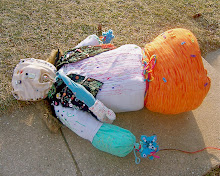Monday, December 15, 2008
The Journey Through Art History
Art Through Time was inspired by many experiences in the traditional art history classroom at the Corcoran College of Art and Design. I recount spending excessive hours studying and reviewing information presented in a traditional book format. I never scored above a B+ on a test and at the moment cannot recall one important fact about the Italian Renaissance. The traditional delivery of sitting in a dark room viewing countless slides did more harm than good. By creating a timeline I realized that I had been cheated of vital information. The timeline improved my memorization and understanding of important monuments such as the Great Stone Tower and the Great Pyramids. The use of video, photo and virtual devices in the art history classroom will help build an understanding of a modern society that is built on layers of history.
Art Through Time presents a virtual timeline that will enhance the art history experience for people interested in art, particularly students in high school and college. Students will not be required to rely on the traditional textbook as the only source of knowledge because the timeline animates the traditional textbook. The timeline is supplemented with videos, links, and photos. The timeline will lead the curious and not-so-curious mind through pivotal events in world history.
The timeline covers work from the Paleolithic art period to the Graffiti art movement. I browsed many museum websites, textbooks, and articles in search of an array of information. I believe the videos demanded most of my time because I listened to each one in entirety and most of the videos were about 5 to 10 minutes long. One of the videos that I planned to embed in the timeline on Egyptian art transitioned from an informative and classic tale of the pyramids to a cult-like proclamation of race and identity. Assuming that I might use this timeline with future classes, I was truly glad that I reviewed each video. The timeline is public and open for the world to see. I could not imagine a student or a parent of a student watching a slanderous video that I unassumingly advocated.
Even though I enjoyed the process and was able to fine-tune my knowledge of art history, I faced many challenges. The events could not be categorized by year, which forced me to use a standard date such as Jan. 1 for each event. I was unable to upload more than one image or embed more than one video, which caused much frustration. I either used the most popular image or work to represent the art period or created multiple entries relative to one art period. The dates in art history became more important and relative to the movement. I was able to see the connection between art movements such as Paleolithic art and Graffiti art.
The activity of creating a timeline will improve memorization and the student ability to connect with the art movements. I enjoyed the creation of the timeline as well as the viewing. During the process of creating the timeline I began to consider the multiple uses of a timeline in the traditional classroom setting. The students can learn from the viewing of the timeline but will benefit most if it is required of them to create a timeline on specific art periods assigned by the teacher. I am concerned a little due to the ease of copying and pasting information.
Narrative....blah!

I attempted to browse independently to find interactive narratives but I was not successful. Radha did a spectacular job finding helpful sources. I revisited her blog and I remain impressed. Not that my endorsement is a sign of worthiness but her blog post on interactive narrative is definitely 'cream of the crop'. I tested a few narratives in search of the easiest to maneuver. Campaign rush seemed to be the most challenging. My adventure began with an overwhelming excitement to 'post-participate' in the campaign. After five minutes I was overcome with unpleasant emotions. Scratching my brain and questioning the resourcefulness of the tool I concluded that the purpose of the narrative was to expose potential workers to the fatigue that present campaign workers went through. I was not amused or excited at the end.

Hurricane Katrina Tempest In Crescent City was a very strange narrative. It was very hard to guide the character through the city by using four arrows and a space bar. This could work as a teaching tool. The student or participant can pick and chose who to interact with which determines the character's ability to move to the next level. The narrative begins with a comic book excerpt which introduces the participant to the purpose of the game.
Darfur is Dying presented an interactive, game-like narrative story. I learned more from this narrative than the ones listed above. The participant is introduced to a large family of characters. I chose a 12-year old girl named Abok. Attempting to guide Abok to the well for water was more difficult than I thought. I failed but learned a lesson. Children and adult women are raped and abused in Darfur. At the end of the journey a passage pops onto the screen informing me that I can help the people in Darfur. I felt more connected to the content due to the presentation. The narrative requires the participant to act or play and through play the participant is exposed to the pain and suffering of the people in Darfur.
Subscribe to:
Posts (Atom)
